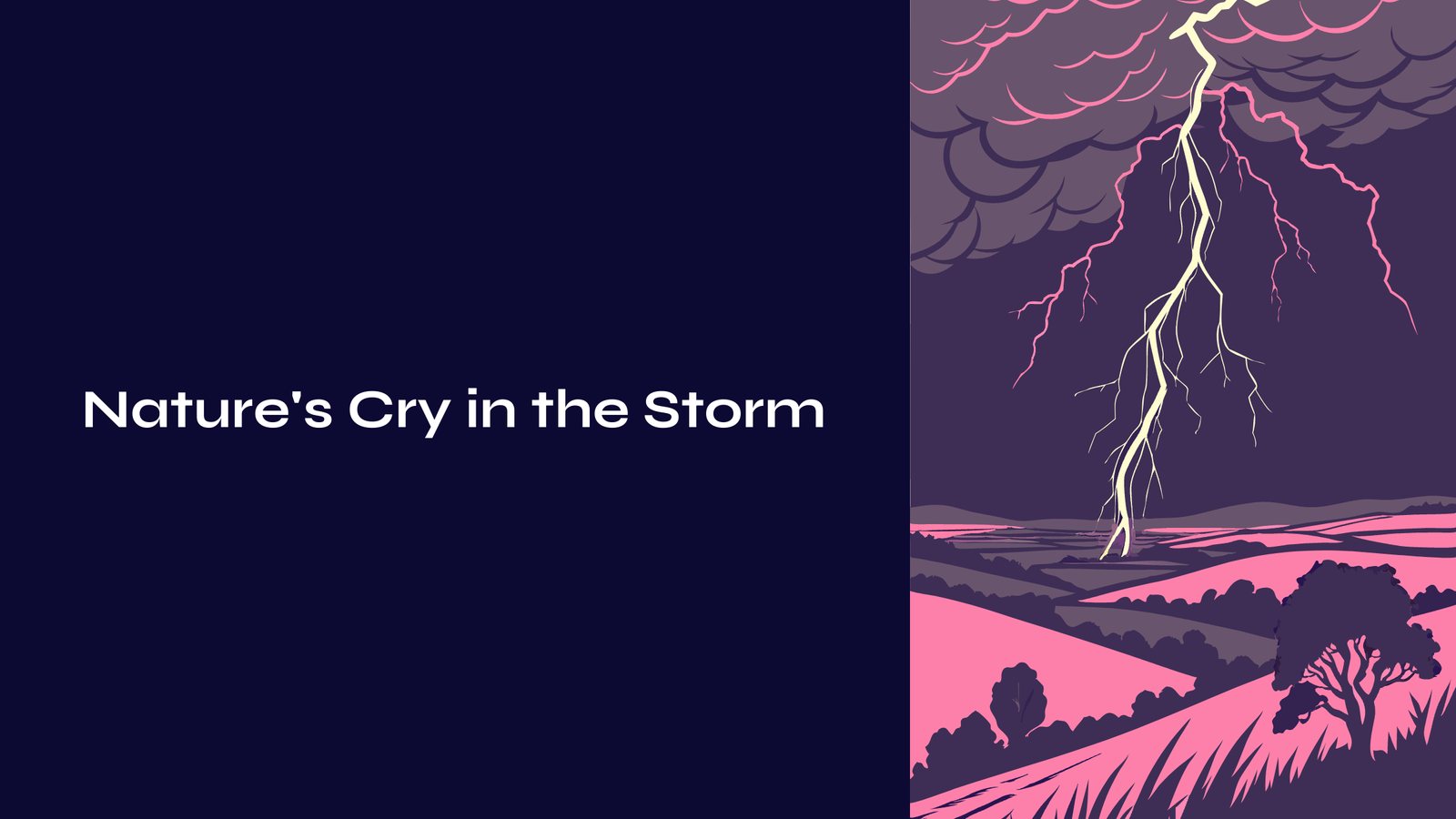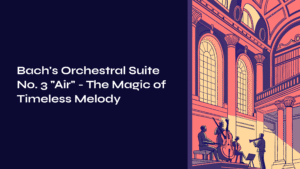Table of Contents
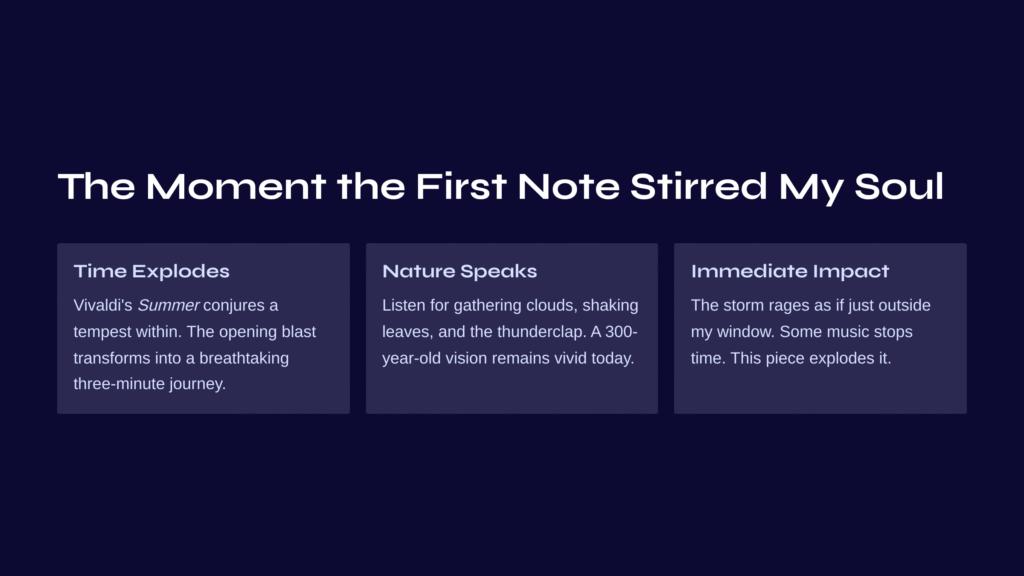
The Moment the First Note Stirred My Soul
Some music stops time. Others explode it. When I first heard Vivaldi’s Summer, 3rd movement, I experienced the latter. From the violin’s opening blast to its final echo, this music conjured a summer tempest within me for three breathtaking minutes.
Listen closely and you’ll hear it all. The sound of storm clouds gathering, wind shaking the leaves, and finally, the thunderclap that changes everything. All of this dances on violin strings. A Venetian composer’s 300-year-old vision of summer still reaches my ears today, as vivid and immediate as if the storm were raging just outside my window.
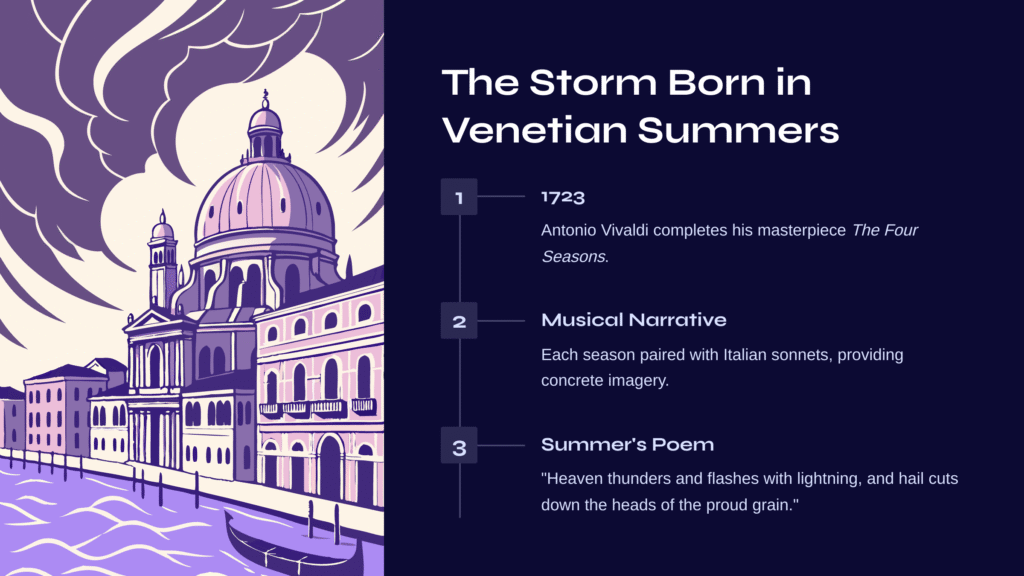
The Storm Born in Venetian Summers
In 1723, Antonio Vivaldi completed his masterpiece The Four Seasons. Among these, Summer holds special significance. This wasn’t merely music—it was a complete narrative. Vivaldi paired each season with Italian sonnets, providing concrete imagery for what the music sought to express.
The poem he wrote for Summer’s final movement reads: “Alas, his fears prove all too true / Heaven thunders and flashes with lightning, and hail / Cuts down the heads of the proud grain and wheat.”
These lines aren’t simple description. They capture human helplessness before nature’s fury, while simultaneously expressing awe at its overwhelming power. Vivaldi was a genius at translating these emotions into musical notes.

Anatomy of a Musical Storm
Ritornello: The Returning Storm Theme
The 3rd movement follows the typical ritornello form of Baroque concertos. The full orchestra’s main theme returns repeatedly, with solo violin episodes displaying brilliant virtuosity in between. But here, the ritornello isn’t just formal structure—it is the storm itself.
The strings’ cascading sixteenth notes sound like torrential rain. Sudden forte bursts mimic thunderclaps, while abrupt quiet moments evoke the eerie calm before the tempest. All of this unfolds within G minor’s dark palette.
Solo Violin: A Soul Racing Through the Storm
The solo violin episodes between ritornellos are this music’s true protagonist. The violin’s melodic lines are anything but smooth—sudden leaps, unpredictable direction changes, and breathless sixteenth-note runs. These passages embody hailstones striking grain and wind-whipped branches thrashing helplessly.
Particularly striking are moments when the violin plummets from high to low registers—like lightning bolts shooting from sky to earth. These sonic effects make listeners’ hearts race.
Presto Time: Compressed Eternity
The movement’s tempo marking reads “Presto – Tempo impetuoso d’estate” (impetuous summer tempo). At roughly 157 beats per minute, this pace allows no breathing room.
Yet strangely, listening to such fast music creates an illusion of slowed time. When adrenaline surges, our senses sharpen and we perceive more than usual. Vivaldi’s tempest offers exactly this kind of heightened temporal experience.
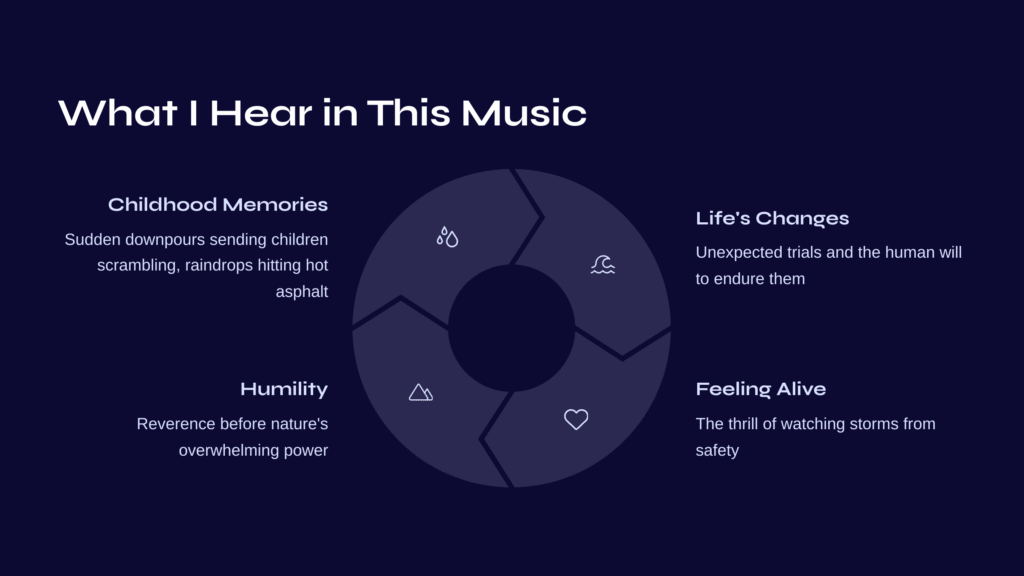
What I Hear in This Music
Each time I listen, different scenes emerge. Sometimes I recall childhood summer days when sudden downpours sent playground children scrambling under eaves, raindrops hitting hot asphalt and releasing that distinctive steamy smell.
Other times I sense more abstract things—life’s unexpected changes, sudden trials, and the human will to endure them all. Like post-storm silence, this music eventually dissolves into peaceful quiet.
Above all, this music makes me feel intensely alive. There’s that thrill of watching storms from safe indoors—reverence for dangerous beauty, humility before nature’s overwhelming power displayed to humanity.
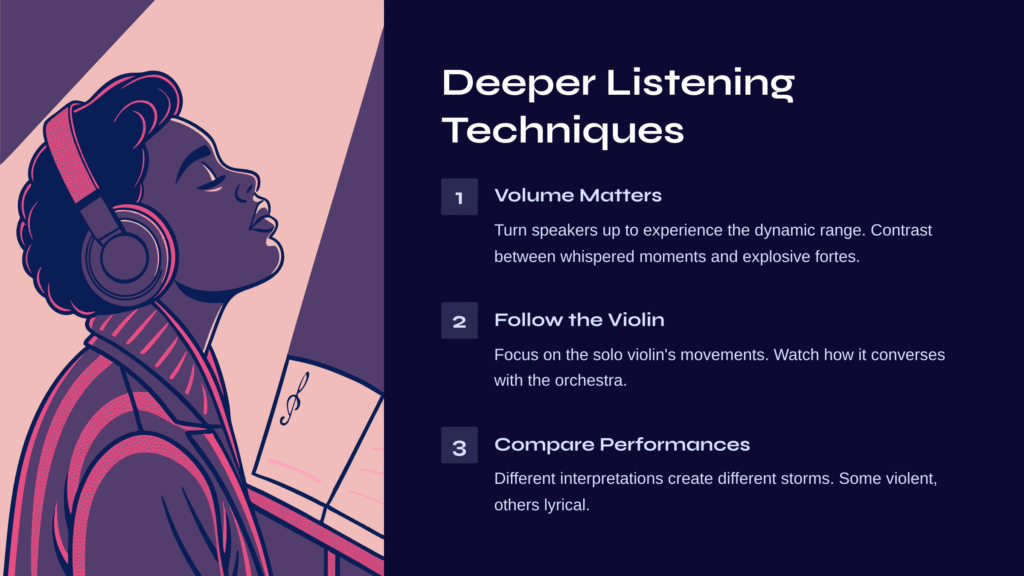
Deeper Listening Techniques
To truly experience this music, keep several things in mind while listening.
First, turn your speakers or headphones up slightly louder than usual. This music’s dynamic range is considerable. The contrast between whispered quiet moments and explosive fortes forms the piece’s core. Soft playback prevents you from fully experiencing this dramatic contrast.
Second, focus on the solo violin’s movements. While the orchestra creates the storm’s backdrop, the violin is the protagonist dancing within it. Listen to how the violin converses with, sometimes confronts, sometimes harmonizes with the orchestra—this reveals the music’s structure more clearly.
Finally, if possible, compare multiple recorded performances. The same score becomes completely different storms under different performers. Some interpretations are more violent, others more lyrical. Within these differences, you’ll discover this music’s infinite possibilities.
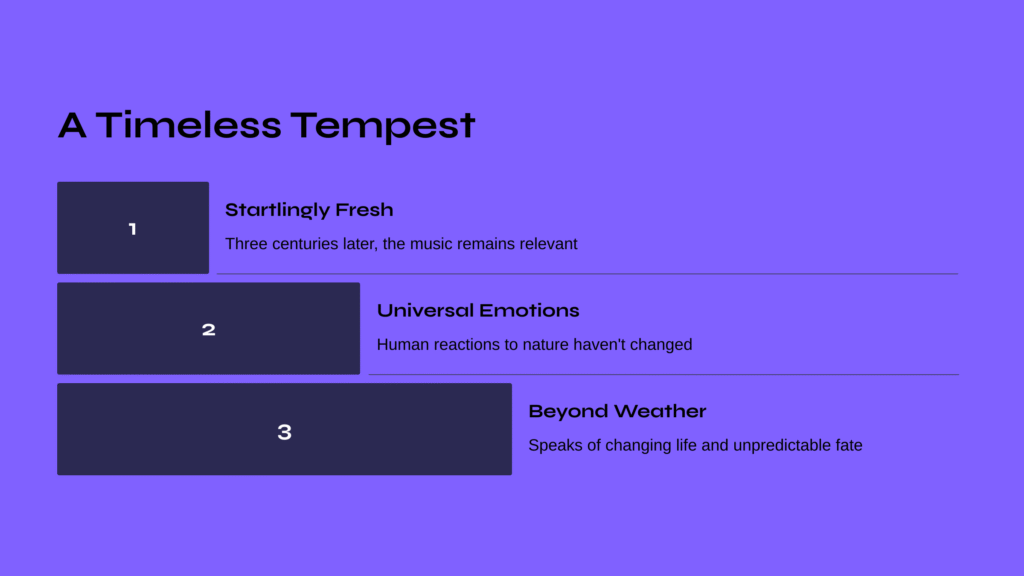
A Timeless Tempest
Three centuries later, this music remains startlingly fresh. Despite technological advancement and global change, human emotions before nature haven’t altered much. We still panic at sudden weather changes, shrink from thunder, and feel relief in post-storm clarity. All these experiences live within Vivaldi’s notation.
Ultimately, this music tells more than a weather story. It speaks of changing life, unpredictable fate, and humanity’s acceptance of both. Storms pass. But their experience remains within us eternally. Vivaldi’s Summer, 3rd movement, is exactly that kind of music.
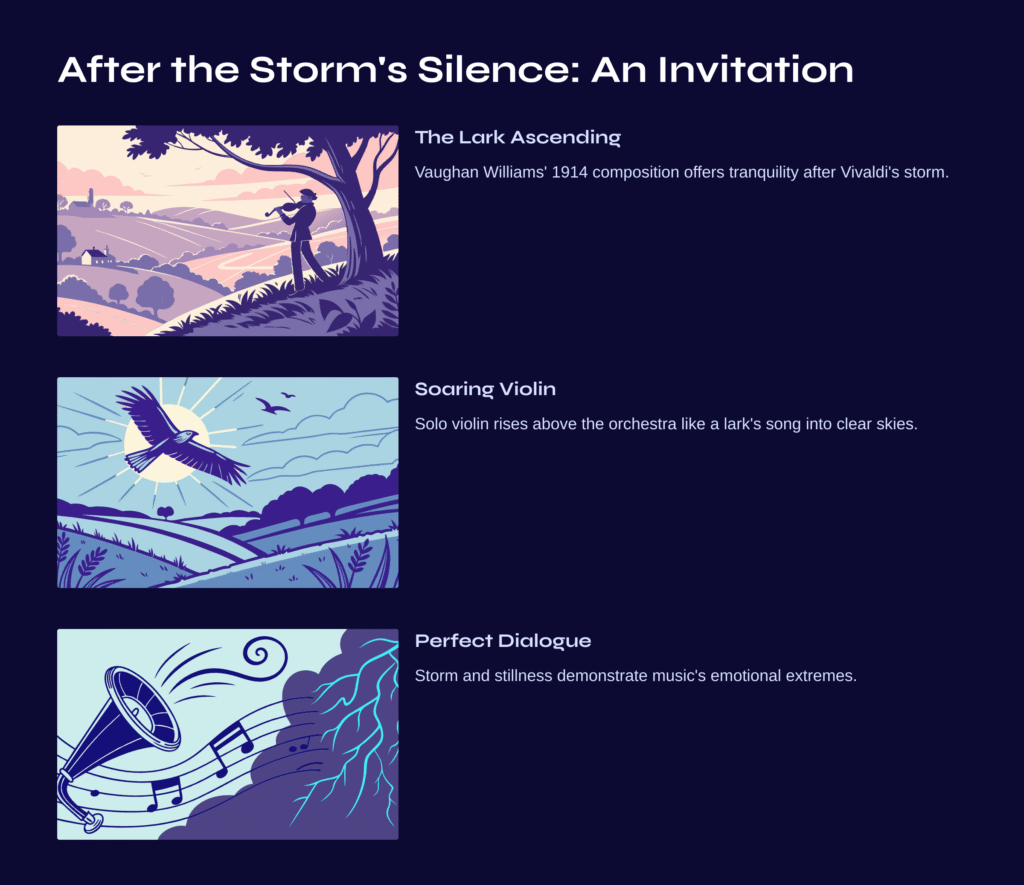
After the Storm’s Silence: An Invitation to the Next Journey
After experiencing Vivaldi’s fierce tempest, what landscape does your heart long for? Probably something from the opposite end of the spectrum—tranquility, peace, and gentle communion with nature.
If so, let’s journey next to Ralph Vaughan Williams’ The Lark Ascending. Composed in 1914, this work unfolds a world diametrically opposed to Vivaldi’s storm. If Vivaldi painted summer’s passion, Vaughan Williams painted an English countryside morning.
This music, with solo violin soaring high above the orchestra, sounds like a lark’s song rising into clear skies after storms have passed. The tension and anxiety felt in Vivaldi transforms into gentle nostalgia and peace. Storm and stillness, passion and lyricism—these two works create perfect dialogue, demonstrating music’s emotional extremes.
Sometimes quiet music penetrates more deeply after intense pieces. Having experienced Vivaldi’s tempest with your whole being, why not fly with Vaughan Williams’ lark into the sky?
